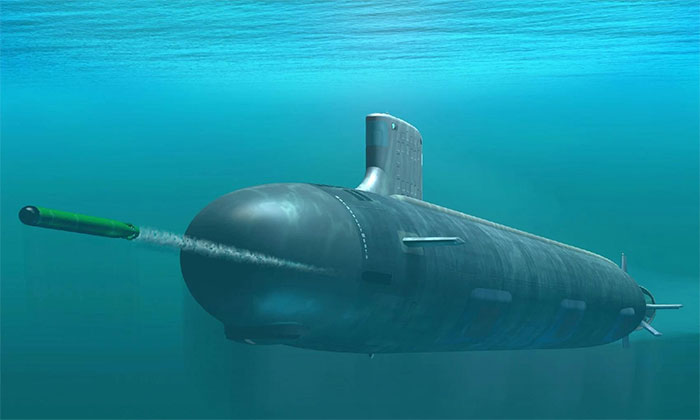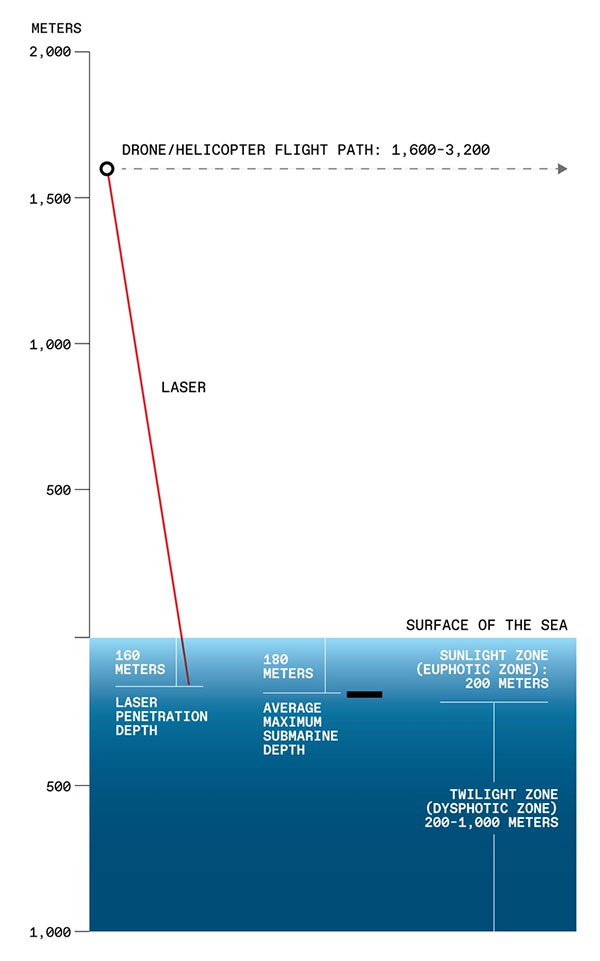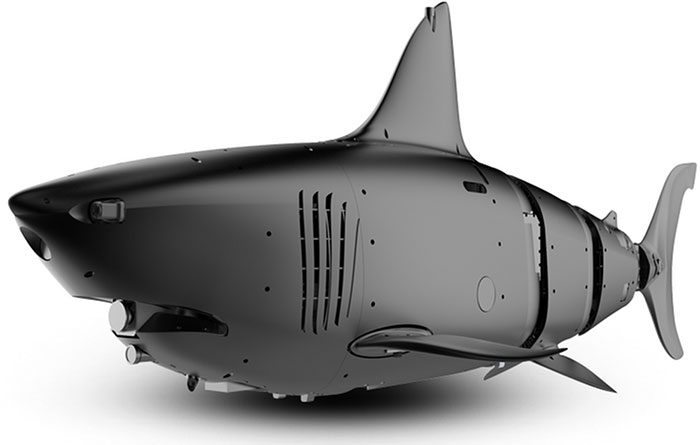Can the use of cutting-edge technology in our era diminish the stealth capabilities of submarines?
Submarines are highly regarded mainly for their underwater stealth capabilities
Ensuring that submarines can “survive” the first missile strike in a nuclear war and thus retaliate by launching missiles in the second strike is key to the deterrence strategy known as mutually assured destruction.
For nearly a century, naval engineers have been striving to develop submarines that are faster and quieter. Concurrently, they have also worked diligently to improve a range of radar, sonar, and other technologies designed to detect, identify, and eliminate enemy submarines.

The balance seemed to shift with the emergence of nuclear-powered submarines in the early 1960s.
In a 2015 study for the Center for Strategic and Budgetary Assessments (USA), Bryan Clark—a naval expert currently with the Hudson Institute—noted that the long-term submerged capabilities of these submarines made them “nearly impossible to detect by radar and sonar.“
However, even these stealthy submarines produce subtle noises at very low frequencies and can be detected from great distances thanks to networks of underwater acoustic sensor arrays. Now, the “submarine hide-and-seek game” may be approaching a point where submarines can no longer evade modern submarine detection technologies.
According to research from the National Security College at the Australian National University in Canberra, this super-sensitive submarine detection technology could arrive as early as 2050.
This timeline is particularly critical because the enormous costs required to design and build a submarine must be amortized over at least 60 years. A submarine entering service today could still be operational in 2082!

A U.S. Navy P-8 Poseidon aircraft, equipped for submarine detection, refueling in Okinawa, Japan, in 2020. (Source: U.S. Navy)
Nuclear-powered submarines, such as the U.S. Navy’s Virginia-class fast attack submarines, each cost around $2.8 billion—according to the U.S. Congressional Budget Office. And that is just the purchase price; the total lifecycle cost of the new Columbia-class ballistic missile submarines is estimated to exceed $395 billion.
Two pressing issues include:
- (1) detecting submarines of rival nations
- (2) protecting one’s own submarines from detection is significant, and of course, technical details must be kept strictly confidential.
Many naval experts are speculating about sensor technologies that could be combined with modern AI methods to neutralize submarines’ stealth capabilities.
Rose Gottemoeller, former Deputy Secretary General of NATO, warns that: “the stealth capabilities of submarines will be difficult to maintain, as technologies capable of sensing all types, across multiple spectrums, in and out of the water become more prevalent.”
Technologies that could “erase” the stealth capabilities of submarines
Current sensor technologies for submarine detection are no longer merely about hearing submarines to accurately locate them through various non-acoustic techniques—but now, submarines can be detected by the small amounts of radiation and chemicals they emit, through slight disturbances in the Earth’s magnetic field, and by reflected light from laser or LED pulses.
All these methods seek to detect anomalies in the natural environment, represented in complex models of baseline conditions developed over the past decade, partly due to advances in Moore’s Law regarding computational capabilities.
According to experts at the Center for Strategic and International Studies in Washington, D.C. (USA), there are two particularly promising methods, including:
- (1) Lidar sensors that transmit laser pulses through water to create highly accurate 3D scans of objects;
- (2) Magnetic anomaly detection (MAD) devices that monitor the Earth’s magnetic field and can detect subtle disturbances caused by the metal hull of a submerged submarine.

Aerial laser-based sensors can detect submarines hiding near the surface. (Source: IEEE SPECTRUM)
However, both sensors have drawbacks.
MAD only works at low altitudes or underwater. It is often not sensitive enough to recognize disturbances caused by submarines amidst many other subtle changes in the electromagnetic field beneath the ocean.
Lidar sensors have better range and resolution and can be installed on satellites, but they consume a lot of power—a standard mobile device with a range of a few hundred meters can burn 25 watts. Moreover, Lidar sensors are also very expensive, especially when operating in space. In 2018, NASA launched a satellite with laser imaging technology to monitor changes on the Earth’s surface—particularly changes in ocean surface patterns. This satellite cost over $1 billion!
Additionally, one way to address the need for precise location is to make sensors mobile. Underwater drone systems can do this, which is why some experts have proposed them as the ultimate anti-submarine capability.
U.S. naval expert Bryan Clark stated that the U.S. Navy is researching a drone capable of operating for 90 days. Drones are also equipped with chemical, optical, and geomagnetic sensors. Furthermore, networked underwater drones that can operate alongside aerial drones could be useful not only for detecting submarines but also for destroying them. That is why several military forces are investing heavily in them.

China’s Robo-Shark – specially designed for hunting submarines. (Photo: ROBOSEA.ORG)
For instance, the Chinese Navy has invested in an underwater drone resembling a fish called Robo-Shark – specifically designed for hunting submarines.
Robo-Shark, a 2.2-meter-long submersible created by Boya Gongdao Robot Technology in Beijing, is said to have capabilities for underwater surveillance and unspecified anti-submarine operations. The company claims that Robo-Shark moves at a speed of 5 meters/second using a three-joint structure to flap its tail fin, producing less noise than a standard propeller.
Meanwhile, the U.S. Navy is developing low-cost drone technology for surveillance missions. Each Locust drone weighs about 6 kg, costs $15,000, and can be equipped with MAD sensors. It can skim low over the ocean surface to detect underwater signals.
Retired Rear Admiral John Gower, former commander of submarines in the Royal Navy, holds a different view. He believes that underwater drones are “the least likely innovation to make a difference in detecting submarine stealth capabilities.”
Instead, a more powerful submarine detection vehicle lies in the “continuous coverage of the Earth’s surface by commercial satellites.” Over 2,800 of these satellites are already in orbit. They are equipped with a range of sensor technologies, including synthetic aperture radar (SAR), scanning downwards while moving from very long distances.
Commercial satellites equipped with SAR and other imaging tools are now reaching resolutions that can compete with government satellites and provide customer access at extremely affordable prices.
Jeffrey Lewis, Director of the East Asia Nonproliferation Program at the James Martin Center for Nonproliferation Studies, frequently uses satellite imagery in his work to monitor nuclear developments. However, tracking submarines is another issue. “Although this is commercially available technology, we still do not see submarines in real-time today. Even if you locate a submarine in real-time, 10 minutes later, it is very hard to find it again.”
Will artificial intelligence do better?
Although these new sensor methods could make submarines easier to detect, none of them can perform the job on their own. WHAT could enable them to work together is the cutting-edge technology of our time: Artificial Intelligence (AI).
Rose Gottemoeller, former Deputy Secretary General of NATO, stated: “As we observe the increasing potential of ubiquitous sensor capabilities combined with the power of big data analytics, it inevitably leads to the question: Is it feasible now?”
Unlike traditional software, which must be pre-programmed, the machine learning strategy employed here, known as deep learning, can identify patterns in data without external assistance.
In 2021 alone, DeepMind’s AlphaFold program (part of Google) achieved a breakthrough in predicting how amino acids fold into proteins, enabling scientists to determine the structure of 98.5% of human proteins. Previous studies in games, particularly Go and chess, demonstrated that deep learning could surpass the best traditional software techniques, even when running on hardware that is not faster.
For AI to function in submarine detection, several technical challenges must be overcome.
The first challenge involves training algorithms, which entails collecting vast amounts of diverse sensor data from continuous satellite coverage over the ocean’s surface, as well as frequent underwater data collection at strategic locations.
Using such data, AI can establish a detailed model of baseline conditions, then feed new data into the model to identify subtle anomalies. Such automated testing is the most promising way to detect submarine presence anywhere in the ocean and predict locations based on past shipping patterns.
The second challenge is the collection, transmission, and processing of large volumes of data in real time. This task will require more computational power than we currently possess, both on fixed and mobile collection platforms.

Snakehead, a large underwater drone designed to be launched and recovered by the U.S. Navy’s nuclear submarines. (Photo: U.S. Navy)
Sylvia Mishra, a nuclear technology officer at the European Leadership Network, a London-based think tank, expressed her concerns: “I am more worried about issues under the ocean.”
“Until recently, movement beneath the oceans was a government objective. However, there is now a growing industry beneath the sea. For instance, companies are laying numerous underwater communication cables, which could lead to more congestion due to the increased number of underwater vehicles and the potential for confusion,” Sylvia Mishra noted.
Confusion may arise from the fact that drones, unlike surface ships, do not fly national flags, making their ownership unclear. This uncertainty, coupled with the possibility that drones could carry lethal payloads, increases the risk that naval forces may perceive a harmless commercial drone as hostile.
Sylvia Mishra stated: “Any action that puts an adversary’s strategic assets at risk could create new flashpoints for conflict and exacerbate the risk of war.”
With the strategic importance of submarine stealth capabilities, retired Rear Admiral John Gower questioned: “Why would any country want to detect and track submarines? – It’s just something you have to do if you want to make a nuclear-armed power nervous.”
As part of its nuclear modernization plan, the U.S. has begun replacing its entire fleet of 14 Ohio-class ballistic missile submarines with new Columbia-class submarines. The replacement program is expected to cost over $128 billion for acquisition and $267 billion over their entire lifecycle.
U.S. government officials and experts justify the high costs of these submarines by emphasizing their critical role in enhancing nuclear deterrence through the invulnerability of the submarine fleet.
“To protect the stealth capabilities of submarines, creative thinking is required,” Sylvia Mishra concluded.




















































